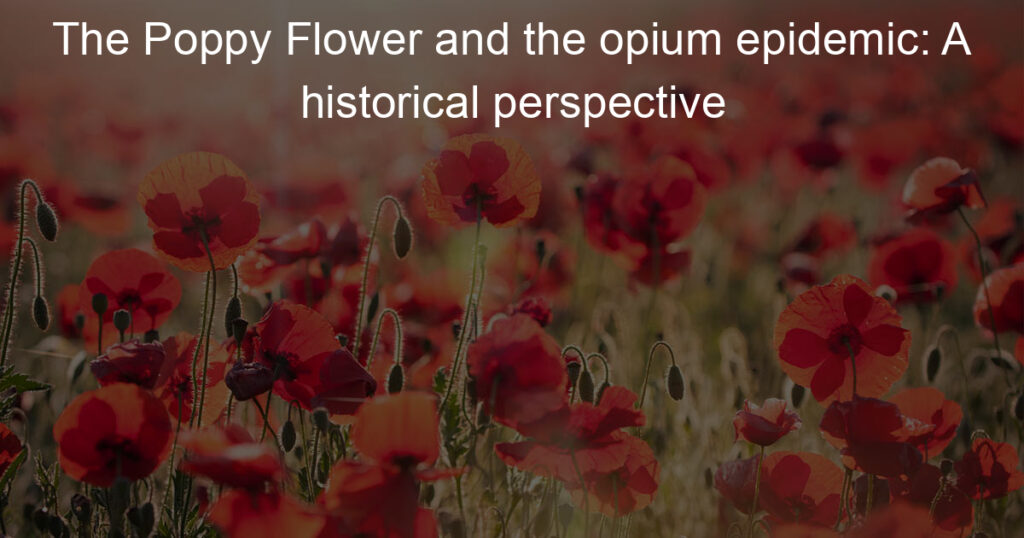If you have a poppy flower garden, then you may be aware of its well-known history with the infamous opium epidemic. Opium is derived from these flowers and has been used for thousands of years as a medicinal supplement in many cultures around the world. Unfortunately, its reputation as an addictive substance led to it becoming illegal and being vilified by governments during the 1800s.
What is the historical use of opium?
Opium has a very long and complex history. For thousands of years, it has been used as a pain reliever in traditional Chinese medicine. By the 1800’s it had become popular throughout Europe as a recreational drug, with usage often driven by addiction.
In the early 20th century, the cultivation and sale of opium were widely banned due to the uncontrollable toll addiction took on people’s lives. In western countries, opium is now largely only used for medical purposes, such as helping those suffering from chronic pain or illnesses.
While its uses may have evolved, it is still important to recognize how deep its history truly runs and think about how we can handle potential issues of abuse today.
What is the biological source of opium poppy?
The opium poppy is one of nature’s true gifts because its biological source, the plant species Papaver somniferum, produces a range of compounds that are incredibly useful for medicinal purposes.
Harvested for thousands of years, these plants release milky white latex containing powerful alkaloids like morphine and codeine that have been used to ease pain and another human suffering around the world.
Sadly, some people have abused these compounds found in the opium poppy as well, leading to difficult social problems that still exist today. This amazing plant has an interesting history and will continue to be studied by humans for many years to come.
Can poppy plants be grown for non-medical use?
Growing poppies for non-medical use is a popular trend among gardeners, as the bright and cheerful flowers make a stunning addition to any garden. They can be grown in gardens, flower beds, and even containers where they require minimal maintenance to showcase their vibrant colors with ease.
Despite being easy to cultivate, they should be handled cautiously while harvesting, as the sticky sap oozing from sections of the plant, can cause skin irritations. Depending on individual preference, poppy plants can either be planted directly into the soil or used as potted plants.
Growing conditions are key when cultivating poppies; once day temperatures rise above 86 degrees Fahrenheit, their blooms will quickly fade away. Overall, it’s not hard to understand why savvy gardeners love growing poppies for non-medical use — it’s an affordable way to have a perennial garden full of bold and beautiful colors!
How are communities affected by the opium epidemic?
The current opium epidemic has had a devasting impact on many communities across the United States. An abundance of opium readily available on the streets has caused more people to become addicted, congregating in certain withdrawal-plagued neighborhoods and straining already limited resources.
Unaddressed mental health disorders, poverty, and crime contribute to even more chaos in the community, as do overbroad prescribing from medical providers.
Opium addiction also takes a huge toll on families, worsening familial breakdowns as money gets spent unwisely and members of the family struggle with addiction. This epidemic is affecting entire communities, not just individuals themselves.
How are poppy farmers regulated?
Poppy farmers are carefully regulated to ensure that their product is used safely and responsibly. For example, they must be licensed by the government and are required to keep detailed records of their harvest, storage, and sale of poppies.
In addition, poppy farmers must adhere to strict security measures imposed by federal laws to guarantee that their crop is not diverted for illegal purposes.
Stringent regulations also protect poppy farmers from being exploited or taken advantage of by buyers in the marketplace. All in all, with strong regulations in place, poppy farmers can produce a secure supply of legal drugs for medicinal use.
What is the impact of the opium crisis?
The opium crisis is having devastating effects on countless individuals, families, and communities across the country. The depth of its impact cannot be understated as it has become one of the most pressing public health issues of our time.
Although fatalities caused by opium overdoses are rightfully garnering much attention, other destructive fallouts from the epidemic such as mental health distress and loss of economic productivity should not be forgotten.
Also, those with addiction may face a lifetime of treatment or social consequences such as incarceration and job loss due to continued abuse and misuse. It is clear that without serious intervention, this crisis will remain an ever-growing challenge to tackle for generations to come.
Conclusion
It is important to remember that the poppy flower may be pretty and delicate, but it holds a darker history. Understanding the opium epidemic of the past can help us to better address addiction issues that still face many countries today. The complexity of the opium pandemic is vast and also heartbreaking. Educating ourselves on the proper and responsible use of poppy plants is part of overcoming this issue.














